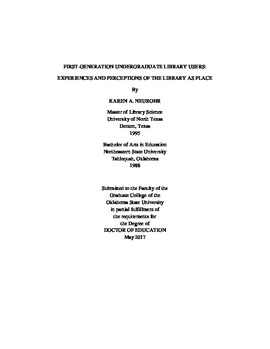| dc.contributor.advisor | Bailey, Lucy E. | |
| dc.contributor.advisor | Kearney, Kerri S. | |
| dc.contributor.author | Neurohr, Karen A. | |
| dc.date.accessioned | 2018-03-13T18:16:12Z | |
| dc.date.available | 2018-03-13T18:16:12Z | |
| dc.date.issued | 2017-05 | |
| dc.identifier.uri | https://hdl.handle.net/11244/54583 | |
| dc.description.abstract | Research focused on first-generation college students has developed considerably in recent years, yet an area that remains relatively unexplored is students' perceptions of the academic library as place. Exploring such perceptions is important for deepening understanding of how the library, as a central academic resource on campus, can best serve this population. | |
| dc.description.abstract | Purpose and Questions: The purpose of my study was to explore Oklahoma State University first-generation undergraduate library users' experiences and perceptions of the Edmon Low Library (hereafter referred to as Library) as place. The four questions and two sub-questions for this study were as follows: | |
| dc.description.abstract | 1. How do first-generation undergraduate library users experience the Library? | |
| dc.description.abstract | 2. How do they perceive the Library? | |
| dc.description.abstract | 3. What aspects of the Library do they identify as meaningful? | |
| dc.description.abstract | a. What are those meanings? | |
| dc.description.abstract | 4. How do they relate to the Library as place? | |
| dc.description.abstract | a. How do those relationships develop? | |
| dc.description.abstract | Methods and Theory: My primary method for this case study was a series of three progressive interviews informed by participant-produced photographs, a diamond-ranking activity, and a time-diary. Analyzing my data inductively, I produced a case representation of each participant. Through cross-case analysis, eight empirical assertions emerged. Place attachment theory emerged as a significant way to draw out nuances in participants' meanings and their sense of the Library as place. | |
| dc.description.abstract | Findings: Participants became attached to the Library as place through their multi-dimensional experiences with library spaces and resources over time. They perceived that the Library "cares" about them because it offers spaces, environmental conditions, and physical resources that support their academic goals. Their use of the Library fostered their self-identity as college students, and they often feel a sense of comfort, community, and belonging in the Library. The Library's striking historic architecture and design is welcoming to participants and improves their attitudes and signifies academic accomplishment. Their interactions with peers and library employees, as well as their past library experiences fostered their relationships to the Library. These important findings have implications for place attachment and student development theory, and for research, and practice in libraries and institutions of higher education. | |
| dc.format | application/pdf | |
| dc.language | en_US | |
| dc.rights | Copyright is held by the author who has granted the Oklahoma State University Library the non-exclusive right to share this material in its institutional repository. Contact Digital Library Services at lib-dls@okstate.edu or 405-744-9161 for the permission policy on the use, reproduction or distribution of this material. | |
| dc.title | First-generation undergraduate library users: Experiences and perceptions of the library as place | |
| dc.contributor.committeeMember | Krumm, Bernita L. | |
| dc.contributor.committeeMember | Wiener, Joshua L. | |
| osu.filename | Neurohr_okstate_0664D_15232.pdf | |
| osu.accesstype | Open Access | |
| dc.type.genre | Dissertation | |
| dc.type.material | Text | |
| thesis.degree.discipline | Higher Education | |
| thesis.degree.grantor | Oklahoma State University | |
